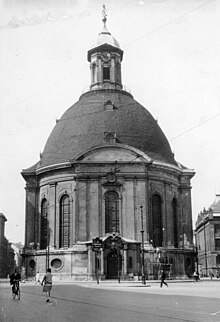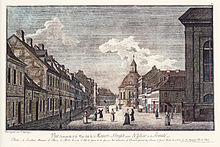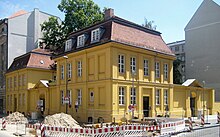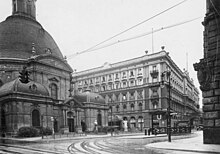
The Protestant Church in Germany, formerly known in English as the Evangelical Church in Germany, is a federation of twenty Lutheran, Reformed, and United Protestant regional Churches in Germany, collectively encompassing the vast majority of the country's Protestants. In 2020, the EKD had a membership of 20,236,000 members, or 24.3% of the German population. It constitutes one of the largest Protestant bodies in the world. Church offices managing the federation are located in Herrenhausen, Hanover, Lower Saxony. Many of its members consider themselves Lutherans.

The Berlin Cathedral, also known as the Evangelical Supreme Parish and Collegiate Church, is a monumental German Protestant church and dynastic tomb on the Museum Island in central Berlin. Having its origins as a castle chapel for the Berlin Palace, several structures have served to house the church since the 15th century. The present collegiate church was built from 1894 to 1905 by order of Emperor William II according to plans by Julius Raschdorff in Renaissance and Baroque Revival styles. The listed building is the largest Protestant church in Germany and one of the most important dynastic tombs in Europe. In addition to church services, the cathedral is used for state ceremonies, concerts and other events.
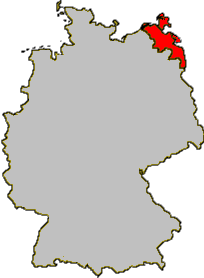
The Pomeranian Evangelical Church was a Protestant regional church in the German state of Mecklenburg-Vorpommern, serving the citizens living in Hither Pomerania. The Pomeranian Evangelical Church was based on the teachings brought forward by Martin Luther and other Reformators during the Reformation. It combined Lutheran and Reformed traditions. The seat of the church was Greifswald, the bishop's preaching venue was the former Collegiate Church of St. Nicholas in Greifswald.

Baron Hermann von Soden was a German Biblical scholar, minister, professor of divinity, and textual theorist.

The Prussian Union of Churches was a major Protestant church body which emerged in 1817 from a series of decrees by Frederick William III of Prussia that united both Lutheran and Reformed denominations in Prussia. Although not the first of its kind, the Prussian Union was the first to occur in a major German state.

Henriette Julie Herz is best known for the "salonnieres" or literary salons that she started with a group of emancipated Jews in Prussia.

Oranienburger Straße is a street in central Berlin. It is located in the borough of Mitte, north of the River Spree, and runs south-east from Friedrichstraße to Hackescher Markt.

Kirche am Hohenzollernplatz is the church of the Evangelical Congregation at Hohenzollernplatz, a member of today's Protestant umbrella Evangelical Church of Berlin-Brandenburg-Silesian Upper Lusatia. The church is located on the eastern side of Hohenzollernplatz in the locality of Wilmersdorf, in the Berlin borough of Charlottenburg-Wilmersdorf. The building is considered a leading example of Brick Expressionism and a testimonial to the unique quality of expressionist church architecture in Berlin. The naming of the church after the city square it faces was originally considered a temporary solution until a more suitable one was chosen. The name stuck however, though the debate continues.
The Evangelical Church Berlin-Brandenburg-Silesian Upper Lusatia is a United Protestant church body in the German states of Brandenburg, Berlin and a part of Saxony.

The New Church, is located in Berlin on the Gendarmenmarkt across from French Church of Friedrichstadt. Its parish comprised the northern part of the then new quarter of Friedrichstadt, which until then belonged to the parish of the congregations of Jerusalem's Church. The Lutheran and Calvinist congregants used German as their native language, as opposed to the French-speaking Calvinist congregation of the adjacent French Church of Friedrichstadt. The congregants' native language combined with the domed tower earned the church its colloquial name Deutscher Dom. While the church physically resembles a cathedral, it is not a cathedral in the formal sense of the word, as it was never the seat of a bishop.
Paulus Stephanus Cassel, born Selig Cassel, was a German Jewish convert to Christianity, writer, orator, and missionary to Jews.

The Sophienkirche is a Protestant church in the Spandauer Vorstadt part of the Berlin-Mitte region of Berlin, eastern Germany. One of its associated cemeteries is the Friedhof II der Sophiengemeinde Berlin.

Jerusalem Church is one of the churches of the Evangelical Congregation in the Friedrichstadt, a member of the Protestant umbrella organisation Evangelical Church of Berlin-Brandenburg-Silesian Upper Lusatia. The present church building is located in Berlin, borough Friedrichshain-Kreuzberg, in the quarter of Friedrichstadt. Jerusalem Church is fourth in rank of the oldest oratories in the town proper.

Jesus Church (Kaulsdorf) (German: Jesuskirche, colloquially also Dorfkirche, village church) is the church of the Evangelical Berlin-Kaulsdorf Congregation, a member of today's Protestant umbrella organisation Evangelical Church of Berlin-Brandenburg-Silesian Upper Lusatia (under this name since 2004). The church building is located in Berlin, borough Marzahn-Hellersdorf, in the locality of Kaulsdorf. The church was named after Jesus of Nazareth. The congregation's parish comprises the area of the historical village of Kaulsdorf, which had been incorporated into Berlin by the Prussian Greater Berlin Act in 1920.
Buß- und Bettag was a public holiday in Germany, and is still a public holiday in Saxony. In Germany, Protestant church bodies of Lutheran, Reformed (Calvinist) and United denominations celebrate a day of repentance and prayer. It is now celebrated on the penultimate Wednesday before the beginning of the Protestant liturgical year on the first Sunday of Advent; in other words, it is the Wednesday that falls between 16 and 22 November. However, it is not a statutory non-working holiday any more, except in the Free State of Saxony. In the Free State of Bavaria, it is a school holiday only.
The Evangelical Lutheran Church in Jordan and the Holy Land (ELCJHL) is a Lutheran denomination that has congregations in Jordan and State of Palestine. First recognized as an autonomous religious community by King Hussein in 1959, the church currently has 2,500 members in six congregations.

The Mehringdamm is a street in southern Kreuzberg, Berlin. In the north it starts at Mehringbrücke and ends - with its southernmost houses already belonging to Tempelhof locality - on Platz der Luftbrücke. It is the historical southbound Berlin-Halle highway, now forming the federal route 96. The main junction of Mehringdamm is with the 19th-century ring road around Berlin's inner city, named Yorckstraße west, and Gneisenaustraße east of Mehringdamm.

Heinrich Grüber was a Reformed theologian, opponent of Nazism and pacifist.
Hans-Jürgen Mende was a German historian. He was a lecturer in the history of philosophy at the Weißensee Academy of Art Berlin. After the reunification of Germany (1989/90) he became founder and managing director of the social and cultural-historical association Luisenstädtischer Bildungsverein, whose main aim was the research and spreading of the history of Berlin and Brandenburg.
